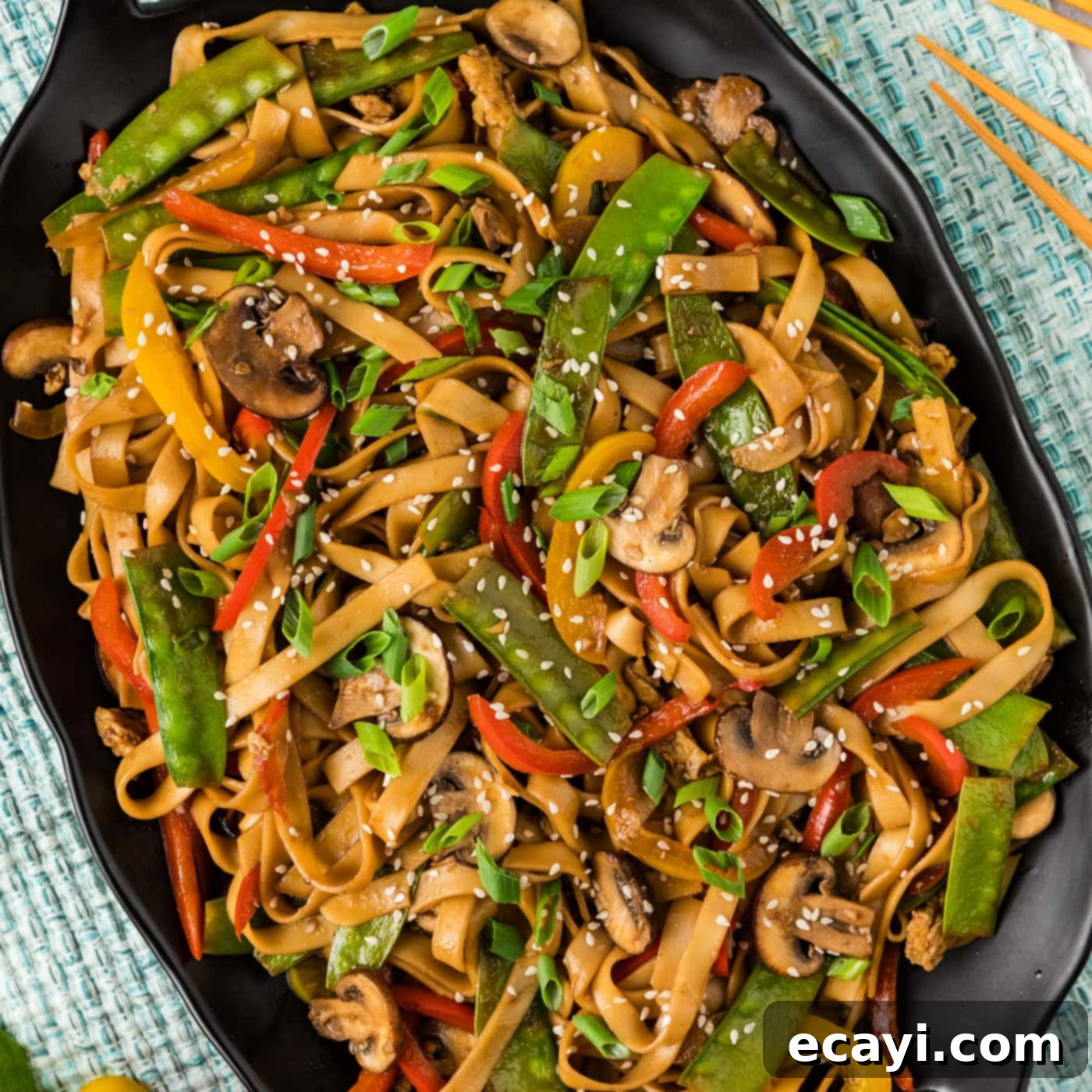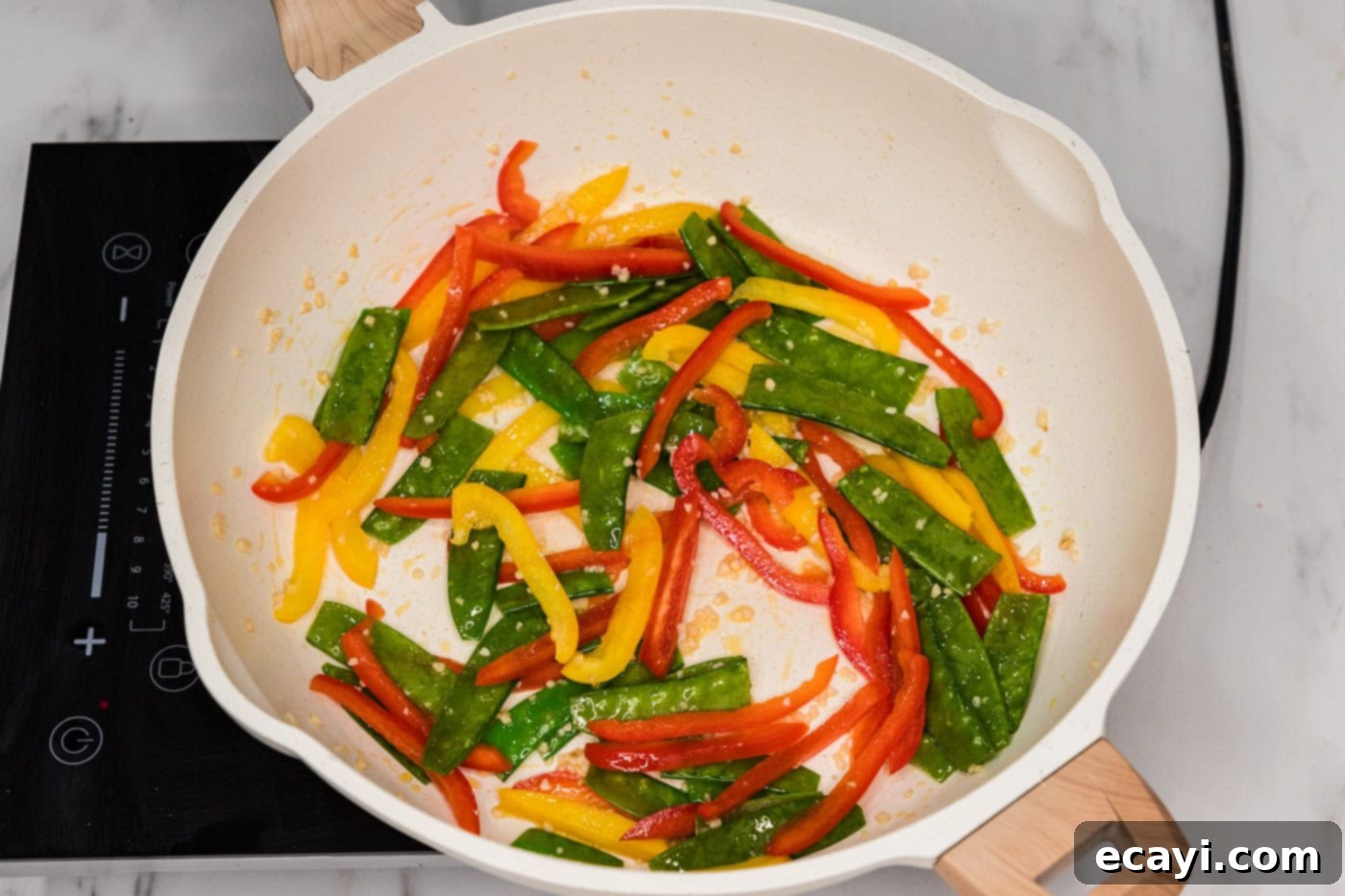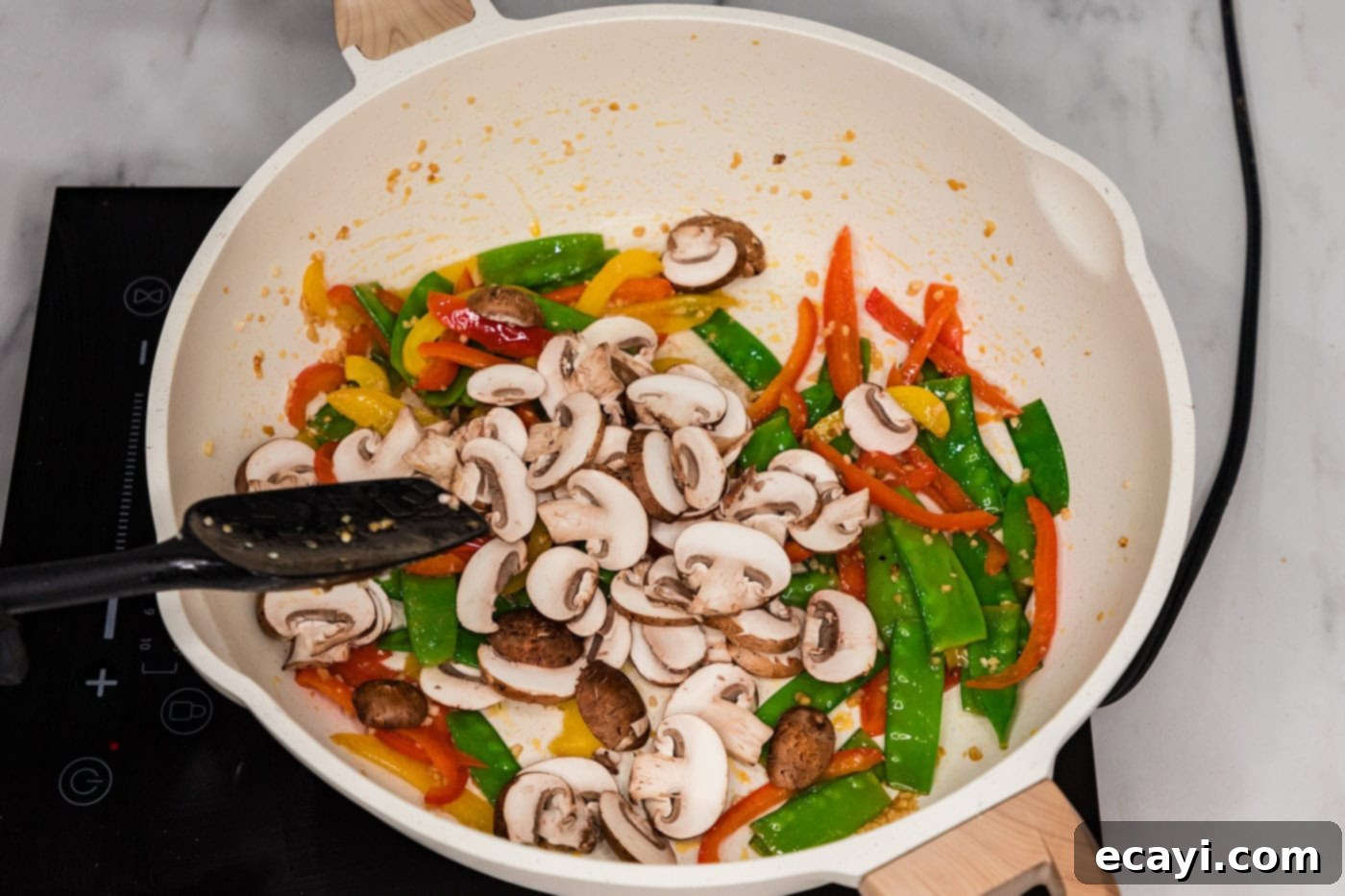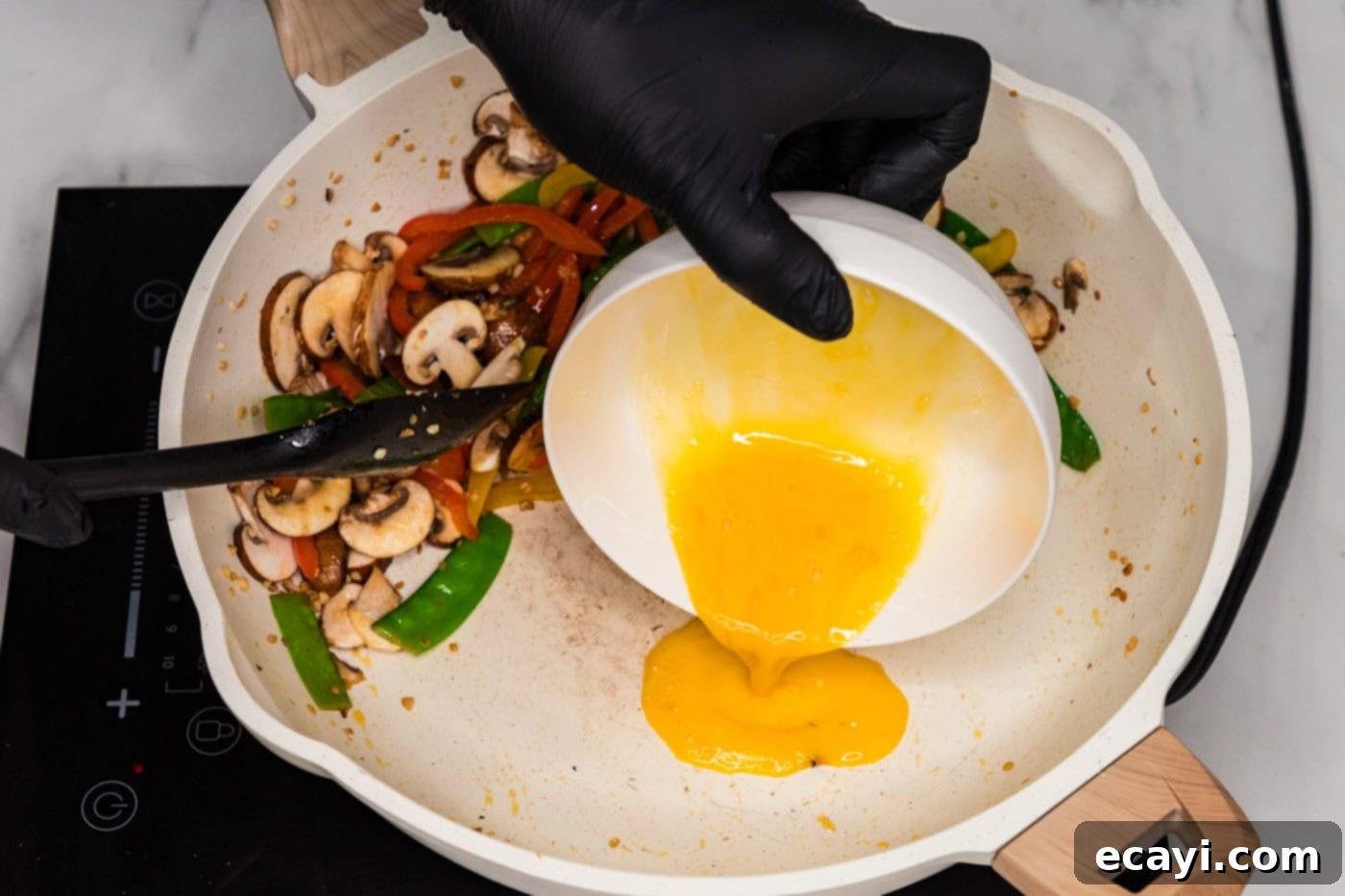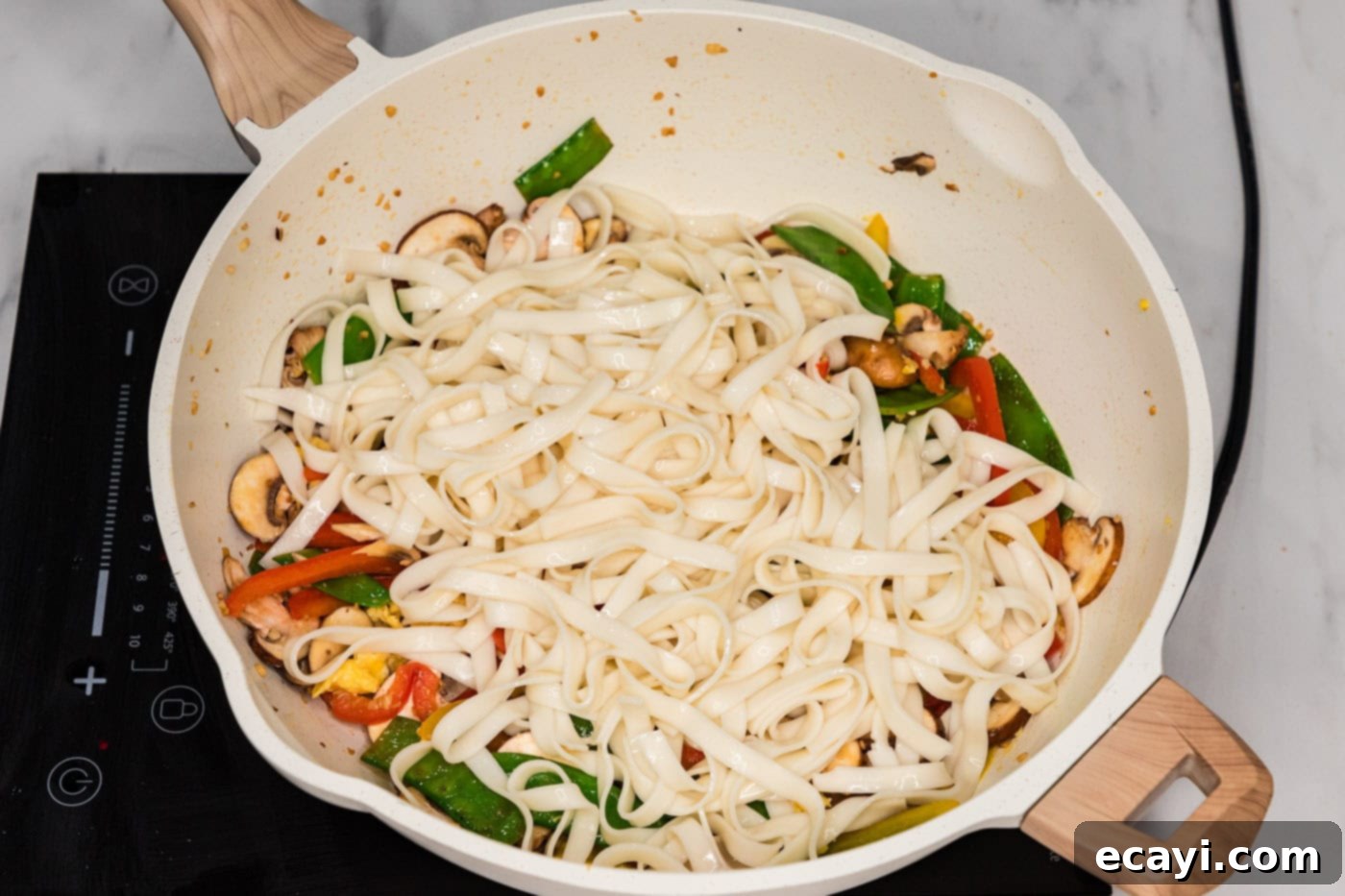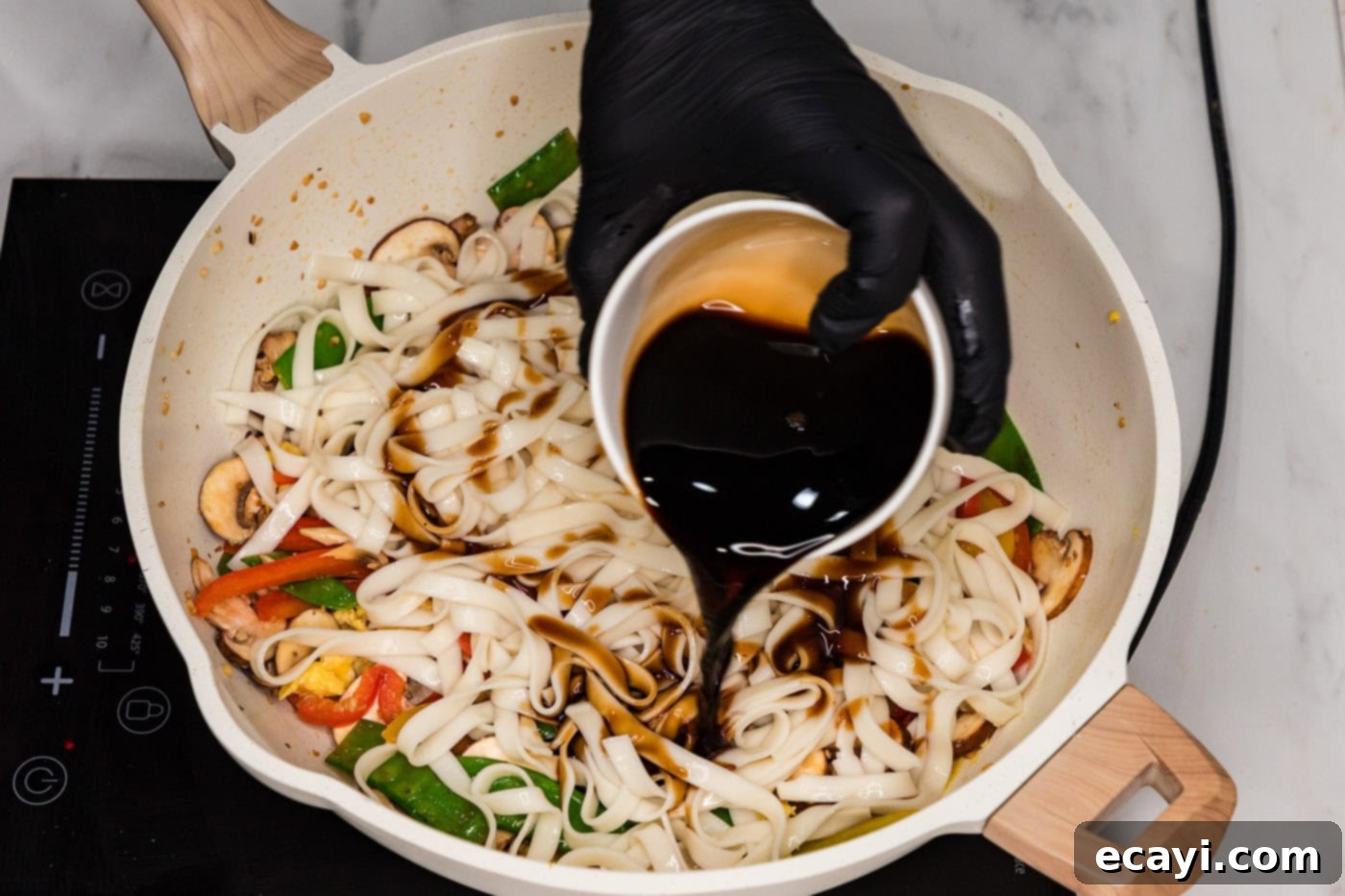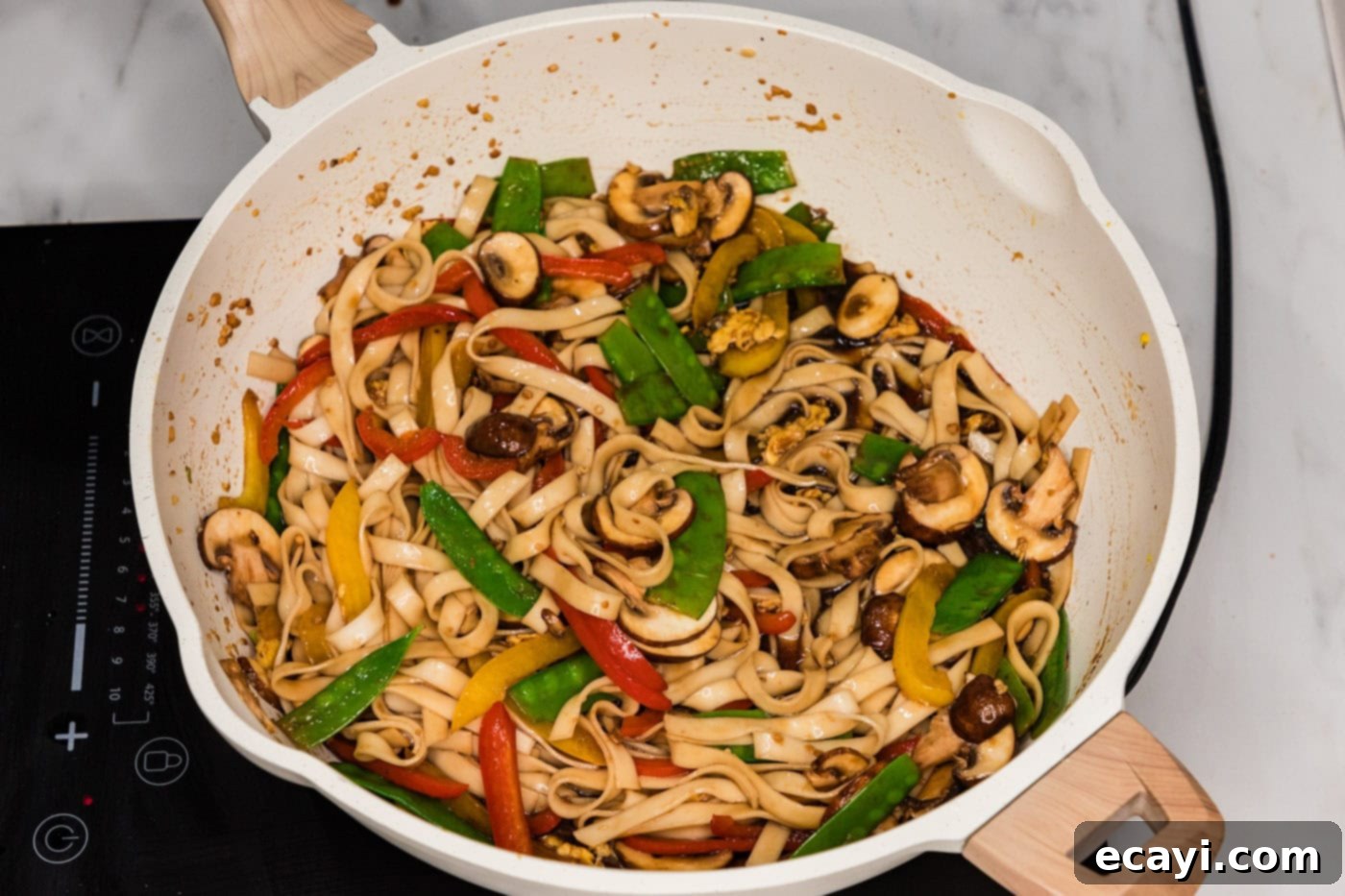Easy 30-Minute Vegetable Lo Mein: Quick & Flavorful Homemade Stir-Fry Noodles
Craving a delicious, restaurant-quality meal without the long wait or complex preparation? This easy 30-minute vegetable lo mein recipe is your answer! Featuring tender noodles stir-fried with vibrant bell peppers, crisp snow peas, earthy mushrooms, and a rich, savory soy-blend sauce, it’s a perfect weeknight dinner. Skip the takeout and create an authentic, satisfying dish right in your own kitchen with minimal effort and maximum flavor.
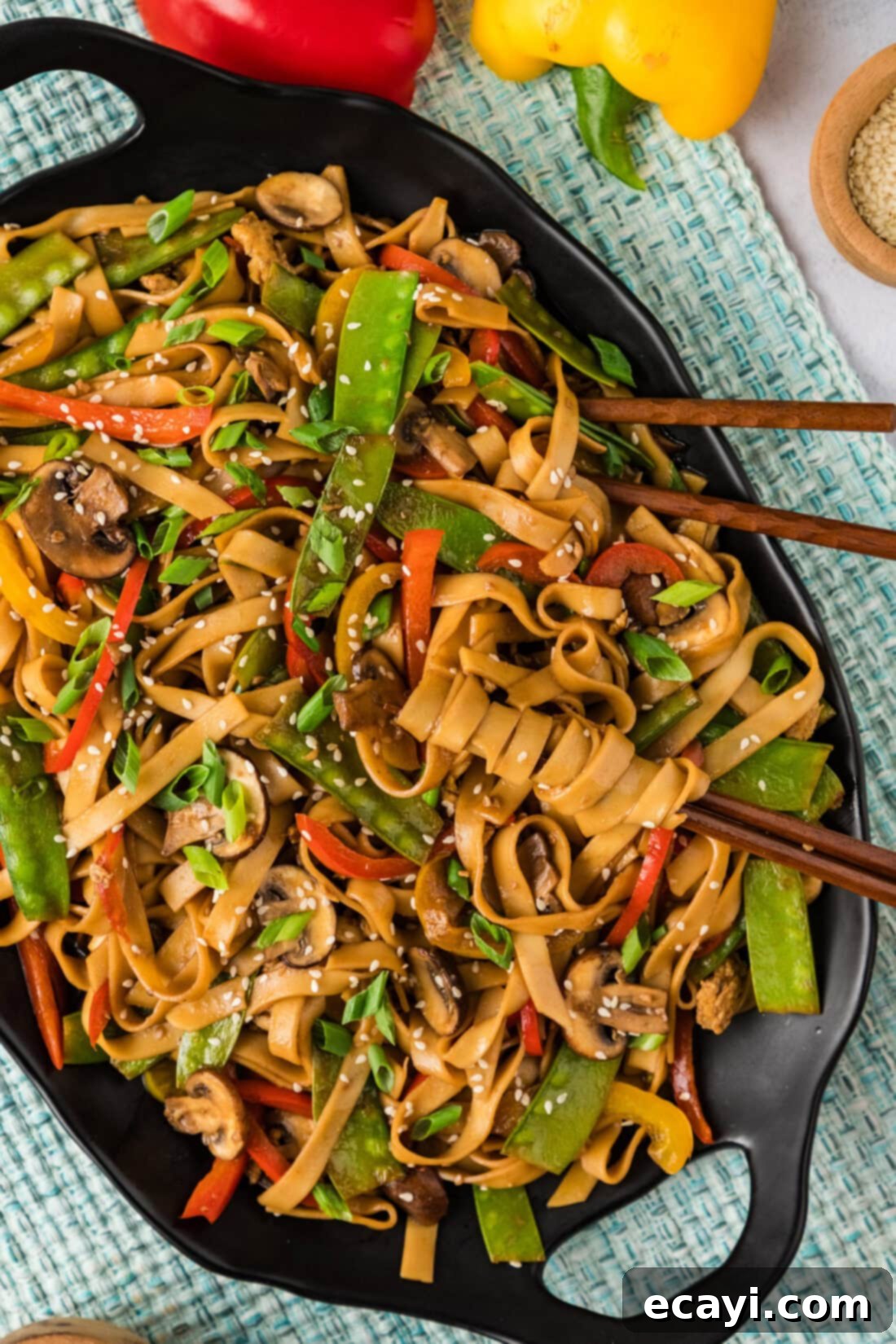
Why This Easy Vegetable Lo Mein Recipe is a Must-Try
There’s simply no wrong time for a generously sized bowl of perfectly cooked vegetable lo mein. This classic stir-fry offers a delightful medley of textures and tastes: crisp-tender vegetables, wonderfully chewy noodles, and a deeply savory, umami-rich sauce that coats every single strand. It’s the ultimate comfort food that also packs in plenty of wholesome goodness.
Our recipe stands out for several reasons. First, it’s incredibly fast, coming together in just 30 minutes, making it ideal for busy evenings when you need a quick, satisfying meal. The combination of colorful bell peppers and snow peas provides a refreshing crunch and sweetness, while the mushrooms add a robust, earthy depth and satisfying heartiness that makes this dish feel complete. This isn’t just a side; it’s a full meal in itself.
Beyond its speed and flavor, this vegetable lo mein is also remarkably versatile. Similar to other popular stir-fries like chow mein, there’s always room for customization. Want to add a protein? Easy. Prefer different vegetables? Go for it. This recipe serves as a fantastic foundation, allowing you to adapt it to your preferences, dietary needs, and whatever ingredients you have on hand. It’s a truly flexible dish that empowers you to be creative in the kitchen, ensuring a delicious outcome every time.
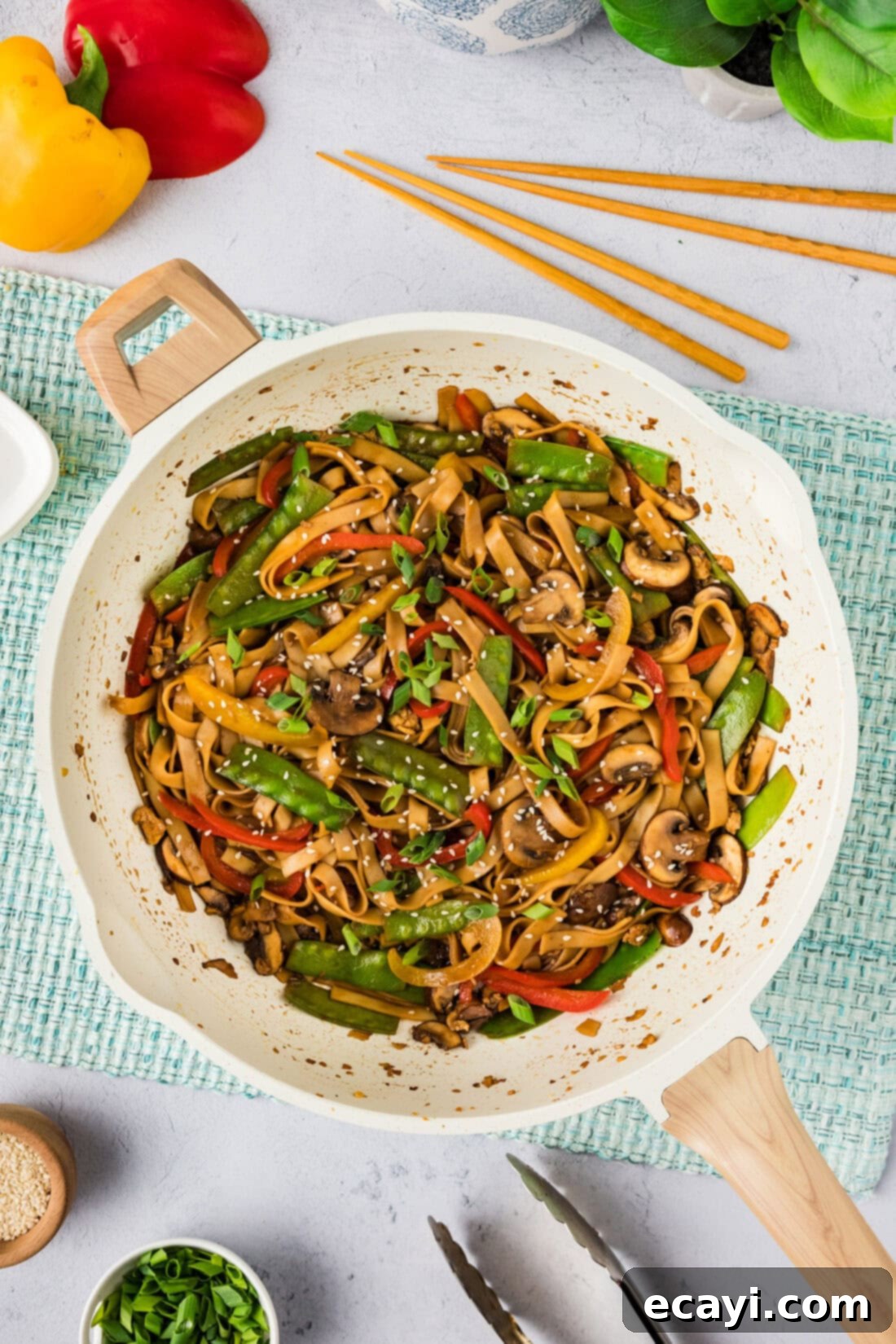
Key Ingredients for Your Homemade Vegetable Lo Mein
To whip up this amazing vegetable lo mein, you’ll need a handful of fresh ingredients and pantry staples. Find all precise measurements, ingredient quantities, and detailed instructions in the printable recipe card located at the very end of this comprehensive guide. Here’s a closer look at what makes this dish so special and how you can tailor it to your liking:
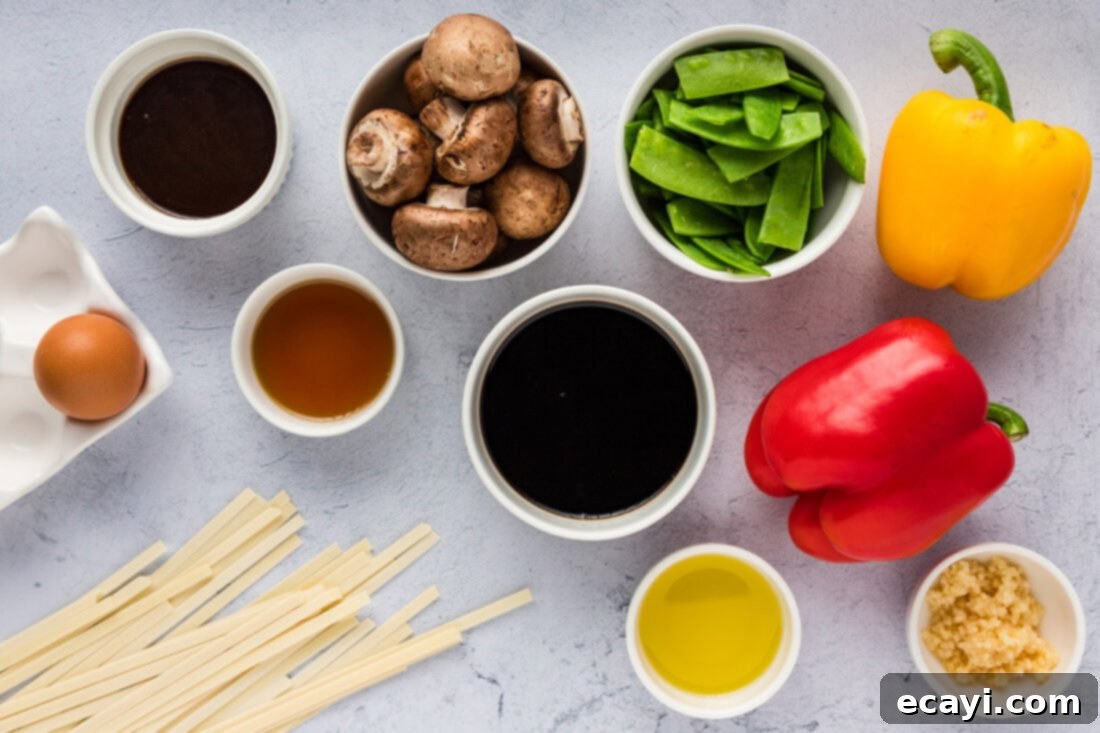
Ingredient Spotlight & Smart Substitutions
Understanding your ingredients is key to successful cooking. Here’s more detail on what to use and how to customize:
- NOODLES: The heart of any lo mein dish! Authentic lo mein noodles or Cantonese egg noodles are ideal for their distinctive chewy texture and ability to absorb sauce beautifully. You’ll typically find these in the international or Asian foods aisle of larger grocery stores. They are often pre-cooked and just need a quick boil to soften before being tossed into the stir-fry. If traditional lo mein noodles are unavailable, don’t fret! You can successfully substitute them with chow mein noodles, ramen noodles (discard the seasoning packet), or even regular spaghetti or linguine for a similar mouthfeel. Just ensure they are cooked al dente, as they will continue to cook slightly in the wok.
- VEGETABLES: Our chosen combination of mushrooms (baby bella or white button), crisp snow peas, and vibrant red and yellow bell peppers provides a fantastic balance of flavor, color, and texture. These vegetables are quickly stir-fried, maintaining a pleasant crunch. However, the beauty of lo mein is its adaptability. Feel free to swap or add any of your favorite stir-fry vegetables. Excellent additions include julienned carrots for sweetness and crunch, finely chopped ginger for a zesty kick, shredded cabbage, sliced celery, broccoli florets, bok choy, or even baby corn. Aim for a variety of colors and textures to make your lo mein visually appealing and nutritionally diverse. Don’t overcrowd your pan; cook vegetables in batches if necessary to ensure proper stir-frying and browning.
- SAUCE: The flavorful foundation of our lo mein comes from a simple yet powerful blend.
- Oyster Sauce: This is a cornerstone of many Asian stir-fries, offering a distinct umami depth and a subtle sweetness. For a vegetarian or vegan version, look for “vegetarian oyster sauce” or “mushroom stir-fry sauce,” which delivers a similar flavor profile without the oyster extract.
- Soy Sauce: The primary source of savory, salty flavor. We recommend using a good quality light soy sauce. For reduced sodium, opt for low-sodium soy sauce. You can also experiment with dark soy sauce for a deeper color and slightly richer flavor, though use sparingly as it can be more intense.
- Sesame Oil: A finishing oil that adds an unmistakable nutty aroma and flavor. Always add sesame oil towards the end of cooking to preserve its delicate fragrance.
- EGG: A whisked egg is scrambled directly in the pan, adding a delicate richness and extra protein to the dish. If you prefer to omit it, the recipe will still be delicious.
- OLIVE OIL & GARLIC: Used for sautéing the vegetables, laying the groundwork for the dish’s aromatic base. Freshly minced garlic is always recommended for the best flavor.
Step-by-Step Guide: How to Make Vegetable Lo Mein
These step-by-step photos and detailed instructions are provided to help you visualize the process of making this incredibly delicious vegetable lo mein. For a printable version of this recipe, complete with precise measurements and comprehensive instructions, please Jump to Recipe at the bottom of this post.
- **Cook the Noodles:** In a large stockpot, bring water to a rolling boil and cook your lo mein noodles according to the package directions until they are al dente. Drain them well and set aside. A quick rinse with cold water can help prevent sticking, but ensure they are very well-drained before adding to the stir-fry.
- **Heat the Oil:** Heat the olive oil in a large skillet or wok over medium-high heat. Wait until the oil is shimmering but not smoking, indicating it’s hot enough for effective stir-frying.
- **Sauté Aromatics and Bell Peppers:** Add the minced garlic, julienned red bell pepper, yellow bell pepper, and snow peas to the hot skillet. Stir-fry for 3-4 minutes, tossing continuously, until the vegetables are crisp-tender and slightly softened but still retain some bite.
-

The initial vegetables getting a good sauté. - **Add Mushrooms and Move Veggies:** Incorporate the sliced mushrooms into the pan and toss them with the other vegetables for another minute. Once all vegetables are cooking nicely, push them to one side of the pan, creating an empty space on the other side.
-

Making space for the egg. - **Scramble the Egg:** Pour the whisked egg into the empty side of the pan. Let it set for a few seconds, then scramble it gently with your spatula until fully cooked.
-

Scrambling the egg directly in the pan for added richness. - **Combine and Add Noodles:** Gently mix the scrambled egg with the cooked vegetables. Then, add the drained lo mein noodles to the skillet. Toss everything together to ensure an even distribution.
-

Noodles joining the party with the fresh vegetables. - **Pour in the Sauce:** Evenly pour in the oyster sauce, soy sauce, and sesame oil over the noodles and vegetables.
-

The savory sauce is added, bringing all the flavors together. - **Final Toss and Heat Through:** Continue to toss and stir-fry all the ingredients for a few minutes, ensuring the sauce is evenly distributed and the entire dish is heated through. The noodles should be beautifully coated and glistening.
-

Perfectly cooked Vegetable Lo Mein, glistening with sauce.
Frequently Asked Questions & Expert Tips for Perfect Lo Mein
Absolutely! Adding protein is a fantastic way to make this dish even more satisfying and a complete meal. Popular choices include chicken, beef, shrimp, or tofu. To incorporate protein, cook your chosen protein source separately (slice chicken or beef thinly and stir-fry until cooked, or pan-fry shrimp/tofu until golden) before you begin stir-frying your vegetables. Set it aside, then add it back to the pan along with the cooked noodles and sauce in the final steps. For more specific guidance, check out our delicious beef lo mein recipe.
Storing leftovers is simple! Transfer any remaining vegetable lo mein into an airtight container and keep it refrigerated for 2-3 days. To reheat, the best method is to gently warm it in a skillet over medium-low heat with a tiny dash of oil or a tablespoon of water or broth. This helps prevent the noodles from drying out or becoming sticky. Stir occasionally until heated through. Microwaving is also an option, but the stovetop method yields better texture.
While both chow mein and lo mein are popular Chinese noodle dishes made with wheat flour noodles, their preparation and resulting texture are distinct. Lo mein noodles are typically thicker, rounder, and often come pre-soaked or partially cooked. They are boiled until tender and then tossed with the other ingredients and sauce, creating a soft, chewy, and “lo” (tossed) noodle experience. Chow mein noodles, on the other hand, are often thinner and traditionally pan-fried until crispy, particularly in American Chinese cuisine, though softer versions exist. When purchased from the store, chow mein noodles usually come dried and require soaking or cooking alongside the other ingredients to achieve their desired texture. Essentially, lo mein emphasizes the soft, tossed noodle, while chow mein focuses on a contrasting crispy or fried noodle texture. Both are incredibly delicious, but it really comes down to your personal preference for noodle texture!
Yes, absolutely! To make this recipe gluten-free, ensure you use gluten-free lo mein noodles (often made from rice or corn starch) and substitute regular soy sauce with a good quality gluten-free tamari. Also, check the label of your oyster sauce, as some brands contain wheat; use a gluten-free version or a gluten-free vegetarian oyster sauce. For a vegan version, simply omit the egg. Replace the oyster sauce with a vegetarian oyster sauce (mushroom-based) and ensure your noodles are egg-free (many lo mein noodles contain egg, so check labels, or use rice vermicelli or spaghetti). This recipe is easily adaptable to suit various dietary needs!
Mastering stir-fry involves a few key techniques:
- High Heat: Use a large wok or skillet and get it really hot before adding oil and ingredients. This creates a good sear and prevents steaming.
- Don’t Overcrowd: Cook vegetables and protein in batches if necessary. Overcrowding lowers the pan temperature, leading to steamed, rather than stir-fried, ingredients.
- Prep Ahead (Mise en Place): Have all your ingredients chopped, measured, and ready to go before you start cooking. Stir-frying is fast, so you won’t have time to chop mid-process.
- Thin Slices: Cut vegetables and any added protein into uniform, bite-sized pieces to ensure even cooking.
- Keep Moving: Constantly stir and toss the ingredients to ensure even cooking and prevent burning.
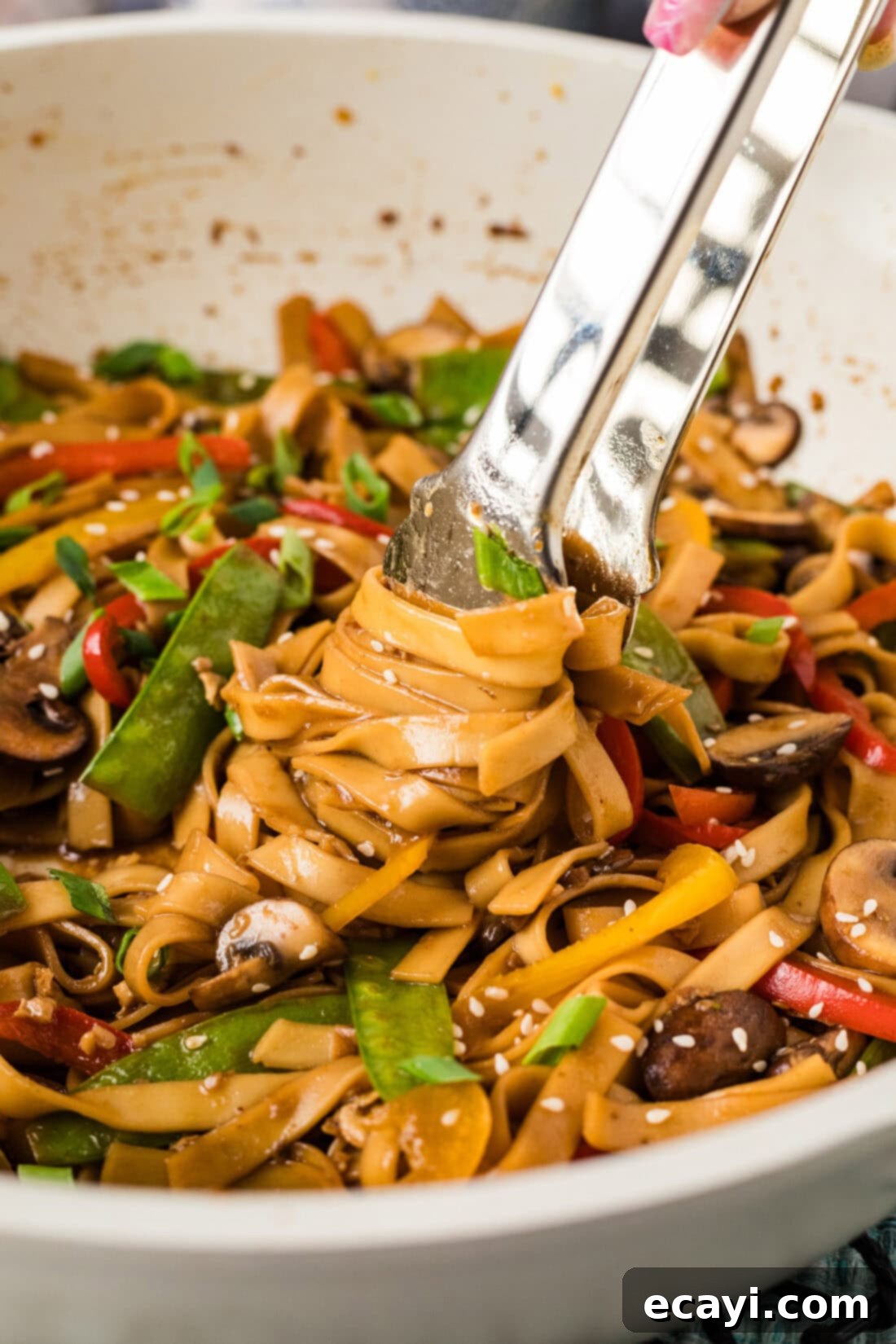
Delicious Serving Suggestions for Your Lo Mein
Our homemade vegetable lo mein is perfectly satisfying on its own, but you can elevate it into a truly memorable meal with a few complementary side dishes. I personally love pairing my vegetable lo mein with crispy appetizers like homemade crab rangoon or savory shrimp egg rolls for that authentic restaurant experience. To transform it into a more substantial and complete meal, consider adding a protein of your choice directly into the stir-fry, such as pan-seared tofu, grilled chicken strips, thinly sliced beef, succulent pork, or fresh shrimp. For an extra touch of flavor and visual appeal, optionally garnish your veggie lo mein with a sprinkle of toasted sesame seeds and freshly chopped green onions before serving. Enjoy this flavorful dish as a light main course or a hearty side!
More Asian-Inspired Noodle & Stir-Fry Recipes to Explore
If you loved this vegetable lo mein, you’re sure to enjoy these other fantastic recipes:
- Classic Chow Mein
- Flavorful Teriyaki Noodles
- Easy Vegetable Fried Rice
- Homemade Sweet and Sour Pork
- Savory Chicken Lo Mein
I absolutely love creating and sharing my kitchen experiences with all of you! Remembering to come back each day for new recipes can be tough, which is why I offer a convenient newsletter delivered straight to your inbox every time a new recipe posts. Simply subscribe today and start receiving your free daily recipes – never miss a delicious update!
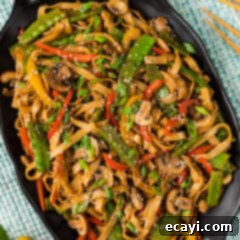
Vegetable Lo Mein
IMPORTANT – There are often Frequently Asked Questions within the blog post that you may find helpful. Simply scroll back up to read them!
Print It
Pin It
Rate It
Save ItSaved!
Ingredients
- 6 ounces lo mein noodles cooked according to package directions
- 2 Tablespoons olive oil
- 1 ½ Tablespoons minced garlic
- ½ yellow bell pepper julienned
- ½ red bell pepper julienned
- 1 cup snow peas
- 8 ounces sliced mushrooms baby bella or white button
- 1 large egg whisked
- 3 Tablespoons oyster sauce
- ½ cup soy sauce
- 1 Tablespoon sesame oil
Equipment You’ll Need
-
Stockpot (for cooking noodles)
-
Large heavy bottomed skillet or wok (for stir-frying)
Before You Begin
- For the best results, use traditional lo mein or Cantonese egg noodles. If unavailable, ramen, chow mein, or even regular spaghetti can be used. Cook noodles according to package directions to al dente.
- Prepare all your vegetables and measure out your sauces before you start cooking. Stir-frying is a quick process, so having everything ready (mise en place) is crucial.
- You can customize the vegetables to your liking! Carrots, cabbage, broccoli, or bok choy are all great additions.
Instructions
-
In a stockpot, cook lo mein noodles according to package directions until al dente. Drain well.6 ounces lo mein noodles
-
Heat olive oil in a large skillet or wok over medium-high heat until shimmering.2 Tablespoons olive oil
-
Add minced garlic, yellow bell pepper, red bell pepper, and snow peas. Sauté for 3-4 minutes until crisp-tender.1 1/2 Tablespoons minced garlic, 1/2 yellow bell pepper, 1/2 red bell pepper, 1 cup snow peas
-
Add sliced mushrooms and toss to combine. Push all vegetables to one side of the pan.8 ounces sliced mushrooms
-
To the empty side of the pan, add the whisked egg and scramble until cooked.1 large egg
-
Combine the scrambled egg with the vegetables and add the cooked lo mein noodles to the pan.
-
Pour in the oyster sauce, soy sauce, and sesame oil over the noodles and vegetables.3 Tablespoons oyster sauce, 1/2 cup soy sauce, 1 Tablespoon sesame oil
-
Toss and cook for a few more minutes, ensuring the sauce evenly coats all ingredients and the dish is heated through. Serve immediately.
Expert Tips & Notes
- Storage: Store leftover vegetable lo mein in an airtight container in the refrigerator for up to 3 days. Reheat gently in a skillet over medium-low heat with a splash of oil or water to prevent drying.
- Customization: Don’t hesitate to add your favorite proteins like chicken, shrimp, beef, or tofu. Cook them before the vegetables and add them back in at the end.
- Gluten-Free Option: Use gluten-free noodles and tamari instead of soy sauce, and check oyster sauce labels for gluten-free options.
- Vegan Option: Omit the egg and use a mushroom-based vegetarian oyster sauce. Ensure your noodles are egg-free.
Nutrition Information (per serving)
The recipes on this blog are tested with a conventional gas oven and gas stovetop. It’s important to note that some ovens, especially as they age, can cook and bake inconsistently. Using an inexpensive oven thermometer can assure you that your oven is truly heating to the proper temperature. If you use a toaster oven or countertop oven, please keep in mind that they may not distribute heat the same as a conventional full sized oven and you may need to adjust your cooking/baking times. In the case of recipes made with a pressure cooker, air fryer, slow cooker, or other appliance, a link to the appliances we use is listed within each respective recipe. For baking recipes where measurements are given by weight, please note that results may not be the same if cups are used instead, and we can’t guarantee success with that method.
